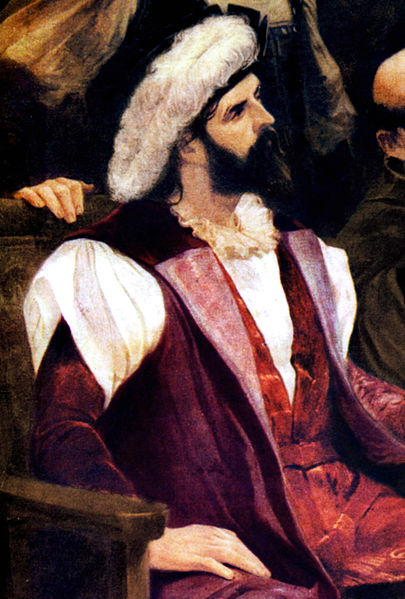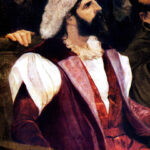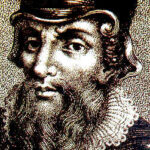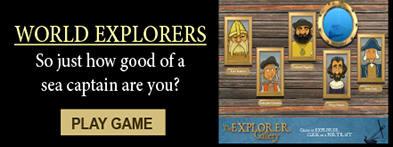Pedro Álvares Cabral
Explorer
Age of Discovery
Quick Facts:
He was the first European to discover Brazil, and also established a successful sea route to India and a leader in trade there

Pedro Álvares Cabral
Detail of painting "Vaz de Caminha reads to Commander Cabral, Friar Henrique and Master João the letter that will be sent to King Dom Manuel I". It depicts Pedro Álvares Cabral, leader of the Portuguese expedition that discovered the land that would later be known as Brazil in 1500.
{{PD-Art}}
Introduction
Pedro Álvares Cabral was a Portuguese explorer who is credited with discovering Brazil in South America. He landed near present-day Bahia off the eastern coast of South America. Several years after Cabral, the Portuguese began colonizing the area. They found great profit by exporting lumber, specifically the brazilwood tree. This was a tropical tree that produces a bright red dye that became very popular. It was also a strong, sturdy wood that was used to make furniture and in ship-building. The name “Brazil” began to be popular in 1503, and was associated with this brazilwood tree.1
Biography
Early Life
Pedro Álvares Cabral was born in Belmonte, Portugal in either 1467 or 1468. Although little is known of his early life, we know that he was the second son and came from a noble family.2 His family was in service to the crown, so young Pedro received his education at the royal court. In 1497, the king of Portugal, King Manuel I, made him part of the king’s council. At this time, the Portuguese were searching for a route to Asia by trying to sail around Africa. Fellow explorer Bartolomeu Dias became the first European to sail around Africa’s southern tip in 1488 but failed to complete the journey to Asia. Nearly ten years later between 1497 and 1498, Portuguese explorer rounded Africa, and made it all the way to Asia, landing in Calicut, India. This accomplishment opened up a faster trade route for the Portuguese empire.
Three years after da Gama’s great journey, the king of Portugal wanted to establish trading ports for Portugal in Asia. He chose Pedro Cabral to head this expedition. It unsure why the king chose Cabral. It is believed that he had little to no sailing experience.3 But he had connections to the king and was loyal to the crown, so this is possibly why he was chosen. In addition to setting up trading relations in India, Cabral was also tasked with spreading Catholicism.4 Catholicism is a branch of the Christian religion, and was practiced throughout many European countries. Explorers throughout the ages believed that most native religions were wrong, so they would press Christianity upon the natives – sometimes by force. Not only was Cabral to follow the same route as da Gama, but he was also to sail farther west into the Atlantic ocean to see if any land was out there to be claimed by Portugal.5 Cabral would indeed find a vast piece of land that would expand the Portuguese empire across the Atlantic.
Voyages
Principal Voyage
Pedro Cabral set sail from Lisbon, Portugal on March 9, 1500. He had a fleet of 13 vessels and 1200 men, including famed explorer Bartolomeu Dias. Dias was in command of one of the vessels. Cabral and his fleet sailed past the Canary Islands and Cape Verde Islands off the coast of Africa. Shortly after leaving, one of Cabral’s ships was missing, and believed to have sunk. Cabral was to follow the same route as da Gama around Africa to India. However, he accidentally sailed too far south west into the Atlantic Ocean. This accident brought him to the South American coast and to a new land unknown to the Europeans. Cabral realized that the land was not India. He and his fleet made achor, at Porto Seguro, on the coast of the present day state of Bahia.6 They went ashore and erected a large wooden cross which he used to claim the land in the name of Portugal. He believed he had landed on an island so he.7 We know this country today as Brazil.
Cabral sent a ship back to Portugal to tell the king of his news. He and the rest of his fleet stayed in Terra de Vera Cruz about 10 days. While here, he interacted with different native people. One account mentions that the natives were curious of the Portuguese’s religion. Several of the Portuguese sailors gave some of the Indians tin crucifixes (crosses) to wear around their necks.8 Cabral was ready to continue his mission to India. Before leaving, he left two members of his crew – both convicts – to further investigate the land.9
Subsequent Voyages
Cabral and his fleet left South America and headed back southeast towards the Cape of Good Hope in Africa. Along the way, the fleet encountered bad storms. On May 24, 1500, the storm sank four of Cabral’s ships, including the one carrying Bartolomeu Dias. Dias and all men aboard the four ships drowned and died. With his remaining six ships, Cabral continued onward to India. They stopped at several African ports along the way including Sofala, Mozambique, and Kilwa. They did not have much luck trading, and often encountered unfriendly natives. So they soon headed onward. They finally reached Calicut, India (today called Kozhikode) on September 13, 1500. His time in Calicut was filled with challenges. Disputes between the Arab traders and the Portuguese were common. At one point, several Portuguese men were killed by the Arabs. Cabral got even by raiding the city and capturing ten Arab ships, and then executing their crew.10 Cabral continued traveling to other Indian cities, selling and trading goods and spices into 1501 before heading back home. He reached Lisbon, Portugal on July 1501.
Later Years and Death
Pedro Cabral’s return to Portugal had mixed reception. He discovered Brazil, and helped set up trade in India. However, relations in India with the Arab traders did not go well. Plus, Cabral lost more than half his fleet and crew along his journey. Still, the king of Portugal gave him command for another voyage to India. Cabral spent several months preparing, but he was replaced by Vasco da Gama shortly before they were to leave.11 Cabral left the king’s court and retired. He eventually got married and had six children. He lived a quiet life until his death in 1520.
Legacy
Pedro Álvares Cabral’s work in India often get overshadowed by Vasco da Gama’s. Also, explorers Amerigo Vespucci, Vincente Yánez Pinzón, and Diego de Lepe all sailed along the Coast of Brazil and went ashore before Cabral. But these trips were all part of a larger expedition, and none claimed the land for their king and country. So we still give Cabral credit for being the first European to discover Brazil. They still speak Portuguese in Brazil today. And with over 150 million people living in Brazil, it is the largest Portuguese speaking nation in the world.12 Cabralia Bay in Brazil is named in honor the explorer.
Endnotes
- Boris Fausto, A Concise History of Brazil (New York: Cambridge University Press, 2014), 9.
- James Stuart Olson, ed., Historical Dictionary of European Imperialism (New York: Greenwood Press, 1991), 104.
- Peter O. Koch, To the Ends of the Earth: The Age of the European Explorers (Jefferson: McFarland & Company, Inc., Publishers, 2003), 149.
- DK, Explorers: Tales of Endurance and Exploration (New York: Tall Tree Ltd., 2010), 96.
- Koch, To the Ends of the Earth, 149.
- Fausto, A Concise History of Brazil, 6.
- Koch, To the Ends of the Earth, 149.
- Koch, To the Ends of the Earth, 149.
- Koch, To the Ends of the Earth, 150.
- Britannica Educational Publishing, Biographies of the New World: Leif Eriksson, Henry Hudson, Charles Darwin, and More, ed. Michael Anderson (New York: Britannica Educational Publishing, 2013), 28.
- Olson, Historical Dictionary of European Imperialism, 106-107.
- V. K. Subramanian, The Great Ones Vol. IV (New Delhi: Abhinav Publications, 2005), 105.
Bibliography
Britannica Educational Publishing. Biographies of the New World: Leif Eriksson, Henry Hudson, Charles Darwin, and More. edited by Michael Anderson. New York: Britannica Educational Publishing, 2013.
DK. Explorers: Tales of Endurance and Exploration. New York: Tall Tree Ltd., 2010.
Fausto, Boris. A Concise History of Brazil. New York: Cambridge University Press, 2014.
Koch, Peter O. To the Ends of the Earth: The Age of the European Explorers. Jefferson: McFarland & Company, Inc., Publishers, 2003.
Olson, James Stuart, ed. Historical Dictionary of European Imperialism. New York: Greenwood Press, 1991.
Subramanian, V. K. The Great Ones Vol. IV. New Delhi: Abhinav Publications, 2005.
Gallery




